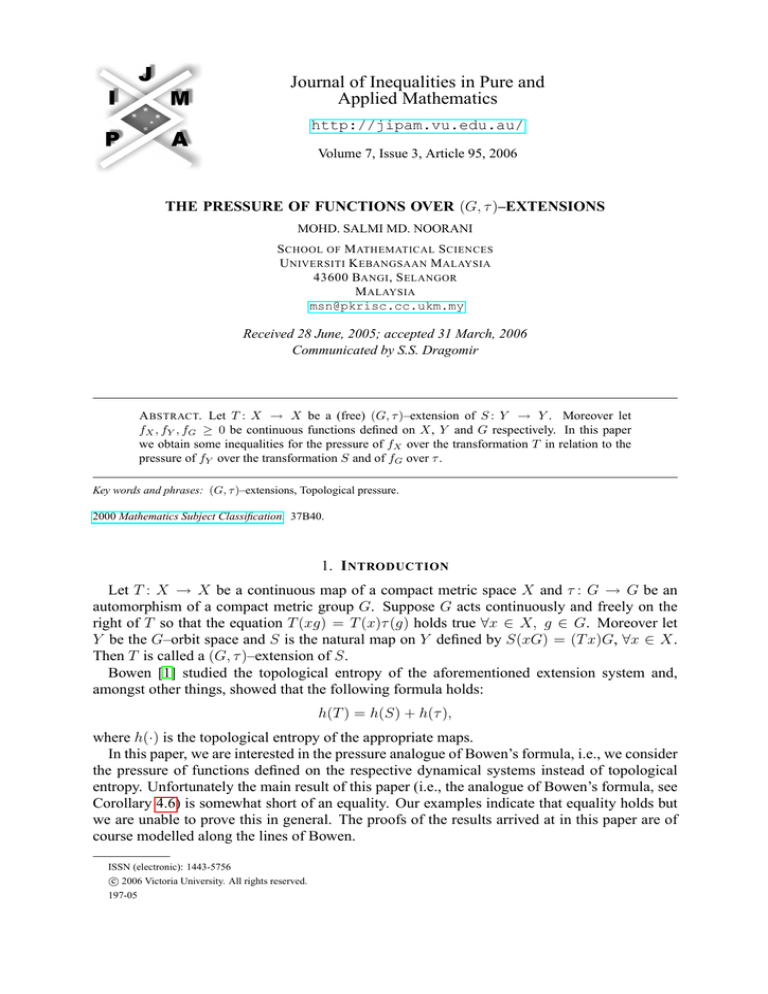
Journal of Inequalities in Pure and
Applied Mathematics
http://jipam.vu.edu.au/
Volume 7, Issue 3, Article 95, 2006
THE PRESSURE OF FUNCTIONS OVER (G, τ )–EXTENSIONS
MOHD. SALMI MD. NOORANI
S CHOOL OF M ATHEMATICAL S CIENCES
U NIVERSITI K EBANGSAAN M ALAYSIA
43600 BANGI , S ELANGOR
M ALAYSIA
msn@pkrisc.cc.ukm.my
Received 28 June, 2005; accepted 31 March, 2006
Communicated by S.S. Dragomir
A BSTRACT. Let T : X → X be a (free) (G, τ )–extension of S : Y → Y . Moreover let
fX , fY , fG ≥ 0 be continuous functions defined on X, Y and G respectively. In this paper
we obtain some inequalities for the pressure of fX over the transformation T in relation to the
pressure of fY over the transformation S and of fG over τ .
Key words and phrases: (G, τ )–extensions, Topological pressure.
2000 Mathematics Subject Classification. 37B40.
1. I NTRODUCTION
Let T : X → X be a continuous map of a compact metric space X and τ : G → G be an
automorphism of a compact metric group G. Suppose G acts continuously and freely on the
right of T so that the equation T (xg) = T (x)τ (g) holds true ∀x ∈ X, g ∈ G. Moreover let
Y be the G–orbit space and S is the natural map on Y defined by S(xG) = (T x)G, ∀x ∈ X.
Then T is called a (G, τ )–extension of S.
Bowen [1] studied the topological entropy of the aforementioned extension system and,
amongst other things, showed that the following formula holds:
h(T ) = h(S) + h(τ ),
where h(·) is the topological entropy of the appropriate maps.
In this paper, we are interested in the pressure analogue of Bowen’s formula, i.e., we consider
the pressure of functions defined on the respective dynamical systems instead of topological
entropy. Unfortunately the main result of this paper (i.e., the analogue of Bowen’s formula, see
Corollary 4.6) is somewhat short of an equality. Our examples indicate that equality holds but
we are unable to prove this in general. The proofs of the results arrived at in this paper are of
course modelled along the lines of Bowen.
ISSN (electronic): 1443-5756
c 2006 Victoria University. All rights reserved.
197-05
2
M OHD . S ALMI M D . N OORANI
2. P RESSURE
We shall recall some elementary facts about pressure which are relevant to us in proving our
results. The references for this section are [2] and [4].
As before let T : X → X be a continuous map of a compact metric space (X, d). Throughout
this paper we shall assume that T have finite topological entropy. Let K be a compact subset
of X. A subset F of X is said to be an (n, )-spanning set for K if for given k ∈ K then there
exists x ∈ F such that d(T i (k), T i (x)) ≤ , ∀0 ≤ i ≤ n − 1. Now let f be a continuous
real-valued function defined on X and consider the set defined by:
(
)
X
Sn f (x)
Qn (T, f, , K) = inf
e
: F (n, )-spans K .
x∈F
(Here we have used the standard notation: Sn f (x) := f (x) + f (T x) + · · · + f (T n−1 x).) Then
it is easy to see that Qn (T, f, , K) ≤ ||eSn f (x) ||rn (T, , K) where rn (T, , K) is the cardinality
of an (n, )-spanning set for K with a minimum number of elements. In particular, by virtue of
compactness and continuity, we have 0 < Qn (T, f, , K) < ∞. Now define:
1
Q(T, f, , K) = lim sup log Qn (T, f, , K)
n→∞ n
Lemma 2.1. Q(T, f, , K) < ∞
Proof. We know that
Qn (T, f, , K) ≤ ||eSn f (x) ||rn (T, , K) < ∞.
Hence, since ||eSn f (x) || ≤ en||f (x)|| , we have
Qn (T, f, , K) ≤ en||f (x)|| rn (T, , K).
Thus
1
1
log Qn (T, f, , K) ≤ ||f || + log rn (T, , K).
n
n
In particular we have
Q(T, f, , K) ≤ ||f || + lim sup
n→∞
It is well known that
lim supn→∞ n1
1
log rn (T, , K).
n
log rn (T, , K) < ∞. Hence this completes the proof.
We are now ready to define the pressure: The pressure of f with respect to the subset K of
X over the map T : X → X is defined by the quantity:
P (T, f, K) = lim Q(T, f, , K).
→0
Remark 2.2.
(1) As is well-known, the metric on X can be arbitrarily chosen as long as it induces the
same topology on X.
(2) When K = X we obtain the usual definition of the pressure, P (T, f ), of the function f
over the map T : X → X.
(3) Recall that E is an (n, )-separated set of K ⊂ X if for any two distinct points x, y ∈ E
there exists some 0 ≤ i < n such that d(T i (x), T i (y)) > . It can be checked that the
above definition can also be arrived at by using separating sets. In this case we shall be
concerned with the quantity
(
)
X
Pn (T, f, , K) = sup
eSn f (x) : E (n, )-separates K .
x∈E
J. Inequal. Pure and Appl. Math., 7(3) Art. 95, 2006
http://jipam.vu.edu.au/
P RESSURE O F F UNCTIONS OVER (G, τ )–E XTENSIONS
3
As is well known, the next step is to define
P (T, f, K) = lim lim inf
→0 n→∞
1
log Pn (T, f, , K).
n
The following two results are straight forward consequences of the definition of pressure.
Proposition 2.3.
P (T, f, K) ≤ P (T, f )
whenever K ⊂ X
Proof. Let F (n, )-span X. Then F also (n, )-spans K ⊂ X. Hence
(
)
(
)
X
X
inf
eSn f (x) : F (n, )-spans K ≤ inf
eSn f (x) : F (n, )-spans X .
x∈F
x∈F
Thus Qn (T, f, , K) ≤ Qn (T, f, ). The result follows by taking the appropriate logarithms and
limits.
Lemma 2.4. Let sn (T, 4, X) denote the cardinality of a (n, 4)-separated set of X with maximum number of elements. Then
Pn (T, f, 8, X) ≤ en||f || sn (T, 4, X).
Proof. For any > 0, it is not difficult to check that Pn (T, f, 2, X) ≤ Qn (T, f, , X) and
rn (T, , X) ≤ sn (T, , X). Hence since Qn (T, f, , X) ≤ ekSn f k rn (T, , X) we have
Pn (T, f, 8, X) ≤ Qn (T, f, 4, X)
≤ ekSn f k rn (T, 4, X)
≤ enkf k sn (T, 4, X).
3. G ENERAL E XTENSIONS
In this section we shall start off with a straightforward modification of a crucial estimate of
Bowen and later show how this estimate is used when dealing with pressure. But first recall the
following definition:
Let T : X → X and S : Y → Y be continuous maps of compact metric spaces X and Y .
Moreover let π be a continuous surjective map from X to Y such that π ◦ T = S ◦ π. Then as
is well-known T is called an extension of S.
With respect to this extension system, we have the following result which is essentially due
to Bowen [1].
Lemma 3.1. Let > 0, α > 0 and integer n > 0 be arbitrary. Also let fX be a continuous
positive function defined on X. Then there exists some δ > 0 such that if Yn is an (n, δ)spanning set for Y with minimum cardinality then for any (n, 4)-separating set F of X we
have
Card. F ≤ Card. Yn · e(a+α)(n+M ) ,
where a = supy∈Y P (T, fX , π −1 (y)) and M is some finite positive real number.
J. Inequal. Pure and Appl. Math., 7(3) Art. 95, 2006
http://jipam.vu.edu.au/
4
M OHD . S ALMI M D . N OORANI
Proof. Let a = supy∈Y P (T, fX , π −1 (y)). For each y ∈ Y , choose an integer m(y) > 0 such
that
(*)
a + α ≥ P (T, fX , π −1 y) + α
1
≥
log Qm(y) (T, fX , , π −1 (y)).
m(y)
Also for each y ∈ Y let Ey be a (m(y), )-spanning set of π −1 (y). Now consider the open
neighborhood of π −1 (y)
[ m(y)−1
\
T −k B2 (T k z).
Uy =
z∈Ey
k=0
Then it is clear that
\
(X/Uy ) ∩
π −1 (Bγ (y)) = ∅,
γ>0
where Bγ (y) is the open-ball centered at y with radius γ. Since X is compact, the finite intersection property for compact sets then implies there exists some γ = γ(y) > 0 such that
π −1 (Bγ (y)) ⊂ Uy . In particular, since X is compact, there exists y1 , y2 , . . . , yr ∈ Y such that
Y is covered by the open balls Bγ (yi ), i = 1, 2, . . . , r and
π −1 (Bγ (yi )) ⊂ Uyi ,
where
m(yi )−1
Uyi =
[
\
z∈Eyi
T −k B2 (T k z)
k=0
−1
and Eyi is an (m(yi ), )-spanning set of π (yi ).
Now let δ > 0 be the Lebesgue number of this cover of Y and let Yn be a (n, δ)-spanning set
for Y with minimum cardinality. Hence for each y ∈ Yn we can define cj (y) as the element in
{y1 , y2 , . . . , yr } satisfying Bδ (S j (y)) ⊂ Bγ (ci (y)) for each j = 0, 1, . . . , n − 1.
Next define recursively the positive integers
t0 (y) = 0,
ts (y) =
s−1
X
m ctr (y) (y)
r=0
for each s = 1, 2, . . . , q, where q = q(y) having the property tq+1 (y) ≥ n. Now for each
q + 1-ple
(x0 , x1 , . . . , xq ) ∈ Ect0 (y) (y) × Ect1 (y) (y) × · · · × Ectq (y) (y)
define the set
V (y; (x0 , x1 , . . . , xq )) = x ∈ X : d T t+ts (y) (x), T t (xs ) < 2
∀0 ≤ t < m cts (y) (y) & 0 ≤ s ≤ q} .
Then it is easy to check that
[
V (y; (x0 , x1 , . . . , xq )) = X
(y;(x0 ,x1 ,...,xq ))
and if F is an (n, 4)-separated subset of X, then
(3.1)
Card.(F ∩ V (y; (x0 , x1 , . . . , xq ))) = 0 or 1
for each q + 2-ple (y; (x0 , x1 , . . . , xq )), where y ∈ Yn and xs ∈ Ects (y) (y) , s = 0, 1, . . . , q.
J. Inequal. Pure and Appl. Math., 7(3) Art. 95, 2006
http://jipam.vu.edu.au/
P RESSURE O F F UNCTIONS OVER (G, τ )–E XTENSIONS
5
To complete the proof of this lemma, we shall now obtain an estimate for the number Ny of
the q + 1-ple’s (x0 , x1 , . . . , xq(y) ). Since
Ny =
q(y)
Y
T, , π −1 cts (y) (y)
rm(ct
s (y) (y))
s=0
we have by virtue of (∗) and fX ≥ 0
log Ny ≤
q(y)
X
log rm(ct
s (y) (y))
T, , π −1 cts (y) (y)
s=0
q(y)
≤
X
log Qm(ct
s (y)
−1
) (T, fX , , π (cts (y) ))
s=0
q(y)
≤
X
m cts (y) (y) (a + α).
s=0
Recall that
tq+1 (y) =
q(y)
X
m cts (y) (y) .
r=0
Also tq+1 (y) = tq (y) + m ctq (y) (y) . Therefore
tq+1 (y) ≤ n − 1 + m ctq (y) (y)
≤ n + M,
where M = max{m(y1 ), m(y2 ), . . . , m(yr )}.
Hence
log Ny ≤ (n + M )(a + α)
so that Ny ≤ e(n+M )(a+α) . In particular, (3.1) now implies
Card. F ≤ Card. Yn · Ny
≤ Card. Yn · e(n+M )(a+α)
and this completes the proof of this lemma.
Some remarks are in order:
(1) Apart from the choices of integers m(y), the rest of the proof of the above lemma is an
exact copy of Bowen’s theorem [1, Theorem 17].
(2) When F is a (n, 4)-separating set of X with maximum cardinality, then
sn (T, 4, X) ≤ rn (S, δ, Y )e(n+M )(a+α)
where as before sn (T, 4, X) is the cardinality of such F and rn (S, δ, Y ) is the cardinality of Yn .
The following theorem is the pressure analogue of Bowen’s Theorem [1, Theorem 17] (see
also [3]).
Theorem 3.2. Let fX and fY be continuous real-valued functions defined on X and Y respectively such that fX ≥ 0 and fY ≥ 0. Then
P (T, fX ) ≤ ||fX || + P (S, fY ) + sup P (T, fX , π −1 y).
y∈Y
J. Inequal. Pure and Appl. Math., 7(3) Art. 95, 2006
http://jipam.vu.edu.au/
6
M OHD . S ALMI M D . N OORANI
Proof. Let > 0, α > 0 and integer n > 0 be arbitrary and a = supy P (T, fX , π −1 y). Also let
sn (T, 4, X) denote the cardinality of a (n, 4)-separated set of X with maximum cardinality.
Then Lemmas 2.4 and 3.1 give us
Pn (T, fX , 8, X) ≤ enkfX k sn (T, 4, X)
≤ enkfX k rn (S, δ, Y )e(n+M )(a+α)
≤ enkfX k Qn (S, fY , δ, Y )e(n+M )(a+α) ,
where the last line follows from the positivity of fY .
Hence
log Pn (T, fX , 8, X) ≤ nkfX k + (n + M )(a + α) + log Qn (S, fY , δ, Y ).
In particular, on dividing by n and taking limit superior, we have as → 0
P (T, fX ) ≤ kfX k + P (S, fY ) + a + α.
The result then follows since α is arbitrary.
Corollary 3.3. Let X and Y be compact metric spaces and T : X → X and π : X → Y be
continuous such that π ◦ T = π. Moreover let f ≥ 0 be continuous on X.Then
sup P (T, f, π −1 y) ≤ P (T, f ) ≤ ||f || + sup P (T, f, π −1 y).
y∈Y
y∈Y
Proof. The first inequality follows from Prop. 2.3. Then in the above theorem take S = Id,
fY = 0 and fX = f .
By taking f = 0 in the above corollary, we have
Corollary 3.4. Let X and Y be compact metric spaces and T : X → X and π : X → Y be
continuous such that π ◦ T = π. Then
h(T ) = sup h(T, π −1 y).
y∈Y
The last corollary is contained in [1, Corollary 18].
4. (G, τ )−E XTENSIONS
As in the introduction let T : X → X be a (G, τ ) - extension of S : Y → Y . For the rest
of this paper let fY and fG be positive real-valued functions defined on Y and G respectively.
Now define the function f : X → R as f (xg) = fY (xG) + fG (g) so that f is also positive and
continuous.
Lemma 4.1. The function f is well-defined.
Proof. Let xg = zg 0 where x, z ∈ X and g, g 0 ∈ G. Consider the projection map π : X → Y .
Then π(xg) = π(zg 0 ) implies xG = zG so that x = zg for some g ∈ G. Hence f (xg) =
f (zgg) = fY (zG)+fG (gg). Also f (zg 0 ) = fY (zG)+fG (g 0 ). And this implies f (xg) = f (zg 0 )
if fG (gg) = fG (g 0 ). But this is true since x = zg implies zgg = zg 0 and in turn by virtue of free
acting this implies gg = g 0 . In other words fG (gg) = fG (g 0 ) and this completes the proof. Let y ∈ Y . Then recall that Qn (T, f, , π −1 y) is defined as
(
)
X
Qn (T, f, , π −1 y) = inf
eSn f (x) : F (n, ) − spans π −1 y .
x∈F
We have
J. Inequal. Pure and Appl. Math., 7(3) Art. 95, 2006
http://jipam.vu.edu.au/
P RESSURE O F F UNCTIONS OVER (G, τ )–E XTENSIONS
7
Proposition 4.2. Given y ∈ Y , integer n ≥ 1 and > 0,
Qn (T, f, , π −1 y) ≤ en||fY || Qn (τ, fG , δ)
for some δ > 0.
Proof. Let d and d0 be the metrics associated with X and G respectively. Then since G acts
continuously on X, we have by uniform continuity, there exists δ > 0 such that d(xg, xg 0 ) ≤ whenever d0 (g, g 0 ) ≤ δ. Now let x ∈ π −1 y and En be a (n, δ)-spanning set for G. Then it is
easy to check that xEn is a (n, )-spanning set for π −1 y. Observe that by commutativity of T
and S (via π) and the relation T (xg) = T (x)τ (g) we have
eSn f (xg) = eSn fY (xG) eSn fG (g)
with respect to the appropriate maps T , S and τ , so that
X
X
eSn f (xg) = eSn fY (xG)
eSn fG (g)
g∈En
g∈En
or
X
eSn f (xg) = eSn fY (zG)
xg∈zEn
X
eSn fG (g) .
g∈En
Therefore
Qn (T, f, , π −1 y) ≤ eSn fY (xG) Qn (τ, fG , δ).
Note that the above manipulation is independent of x ∈ π −1 y since if x0 ∈ π −1 y then x0 = xg
for some g ∈ G so that x0 G = xG which in turn implies Sn fY (x0 G) = Sn fY (xG). The result
follows since eSn fY (xG) ≤ enkfY k .
Theorem 4.3. Given y ∈ Y , we have
P (T, f, π −1 y) ≤ kfY k + P (τ, fG ).
Proof. From Proposition 4.2 we have
Qn (T, f, , π −1 y) ≤ en||fY || Qn (τ, fG , δ).
Therefore
lim sup
1
1
log Qn (T, f, , π −1 y) ≤ kfY k + lim sup log Qn (τ, fG , δ),
n
n
that is
Q(T, f, , π −1 y) ≤ ||fY || + Q(τ, fG , δ).
The result follows by taking → 0 and δ → 0.
Combining Theorem 3.2 and Theorem 4.3 and taking f = fX , we have
Proposition 4.4.
P (T, f ) ≤ kf k + kfY k + P (S, fY ) + P (τ, fG )
We also have:
Proposition 4.5.
P (T, f ) ≥ P (S, fY ) + P (τ, fG )
J. Inequal. Pure and Appl. Math., 7(3) Art. 95, 2006
http://jipam.vu.edu.au/
8
M OHD . S ALMI M D . N OORANI
Proof. Let > 0 and let d00 be the metric on Y . Then by the uniform continuity of π and the
fact that G-acts freely on X there exists some δ > 0 such that
a. d00 (π(x), π(z)) ≤ when d(x, z) ≤ δ
b. d(xg, xg 0 ) > δ when x ∈ X and d(g, g 0 ) > .
Now let Gn ⊂ G be (n, )-separated and Yn ⊂ Y be (n, )-separated and choose Xn ⊂ X so
that π|Xn : Xn → Yn is a bijection. Then Xn Gn is (n, δ)-separated. Thus
X
Pn (T, f, δ) ≥
e(Sn f )(xg) = Pn (S, fY , ) · P (τ, fG , ).
xg∈Xn Gn
In particular
P (T, f, δ) ≥ P (S, fY , ) + P (τ, fG , ).
The result follows by taking → ∞ and δ → ∞.
Corollary 4.6.
P (S, fY ) + P (τ, fG ) ≤ P (T, f ) ≤ kf k + kfY k + P (S, fY ) + P (τ, fG ).
And by taking fY ≡ 0 ≡ fG , we recover Bowen’s formula
Corollary 4.7.
h(T ) = h(S) + h(τ ).
5. F INAL R EMARKS
When fY and fG are both constant, by using the variational formula for pressure and Bowen’s
formula, it is easy to deduce that P (T, f ) = P (S, fY ) + P (τ, fG ), i.e., equality holds in this
trivial case.
Perhaps, a non-trivial example supporting the equality is as follows:
Example 5.1. Let Y = {−1, 1}Z and σ : Y → Y be the full two-shift. Consider the group
extension given by
σ̂ : Y × Z3 → Y × Z3
(y, g) 7→ (σy, (g + 2y0 ) mod 3).
Of course, in this case τ = Id. Also, let f (y, g) = fY (y) + fG (g), where fY (y) = 0 if y0 = −1,
fY (y) = 1 if y0 = 1 and fG = 2, constant. Then one can easily check that P (σ, fY ) = log(1+e)
and P (Id, fG ) = 2. Moreover it is not difficult to see that P (σ̂, f ) = log(e2 + e3 ). In particular,
we have P (σ̂, f ) = P (σ, fY ) + P (Id, fG ).
We end with the following conjecture:
Conjecture 5.1. Let T : X → X be a (free) (G, τ )–extension of S : Y → Y such that T has
finite topological entropy. Also let f : G → R be defined as f (xg) = fY (xG) + fG (g) where
fY , fG are positive real-valued functions on Y and G respectively. Then
P (T, f ) = P (S, fY ) + P (τ, fG ).
R EFERENCES
[1] R. BOWEN, Entropy for group endormorphisms and homogeneous spaces, Trans. Amer. Math. Soc.,
153 (1971), 401–414.
[2] A. KATOK AND B. HASSELBLATT, Introduction to the Modern Theory of Dynamical Systems,
Cambridge University Press, Cambridge, 1995.
[3] H.B. KEYNES, Lifting topological entropy, Proc. Amer. Math. Soc., 24 (1970), 440–445.
J. Inequal. Pure and Appl. Math., 7(3) Art. 95, 2006
http://jipam.vu.edu.au/
P RESSURE O F F UNCTIONS OVER (G, τ )–E XTENSIONS
9
[4] P. WALTERS, An Introduction To Ergodic Theory, GTM 79, Springer-Verlag, Berlin, 1982.
J. Inequal. Pure and Appl. Math., 7(3) Art. 95, 2006
http://jipam.vu.edu.au/





